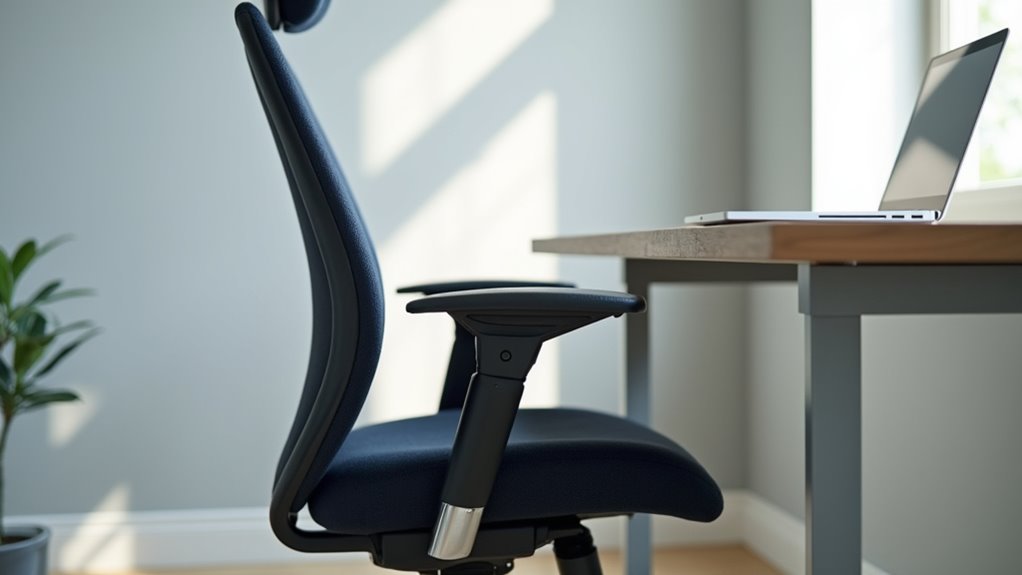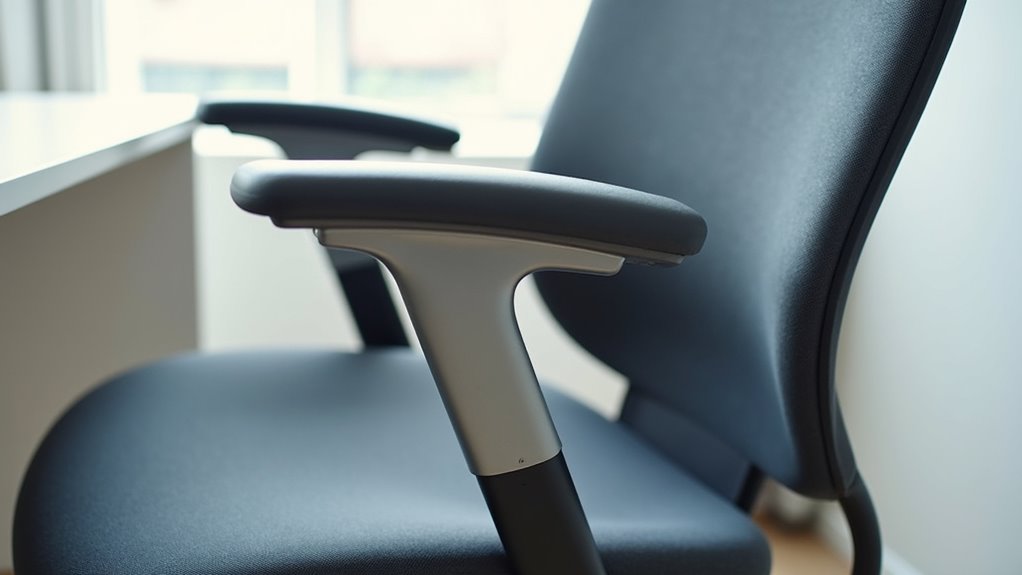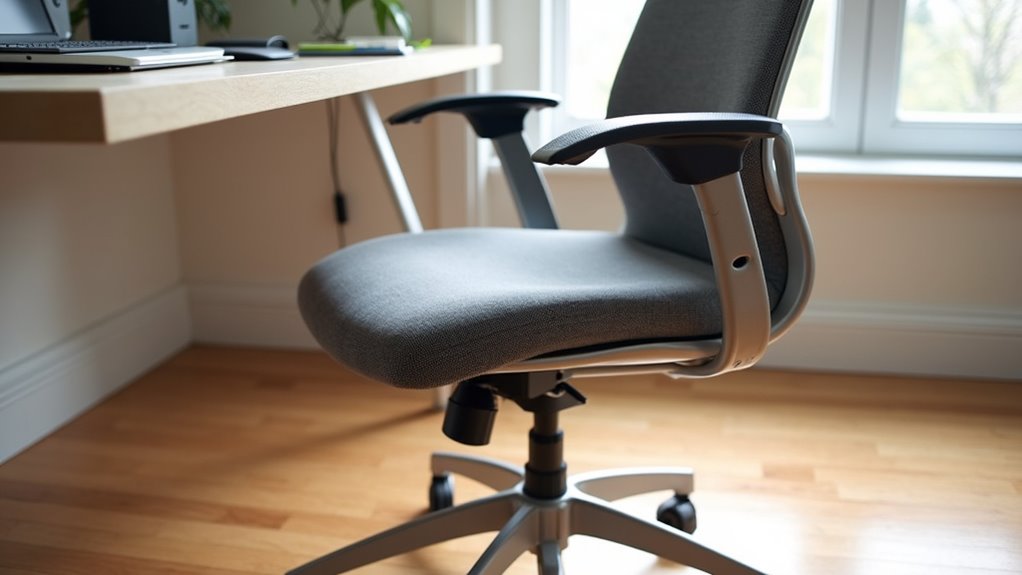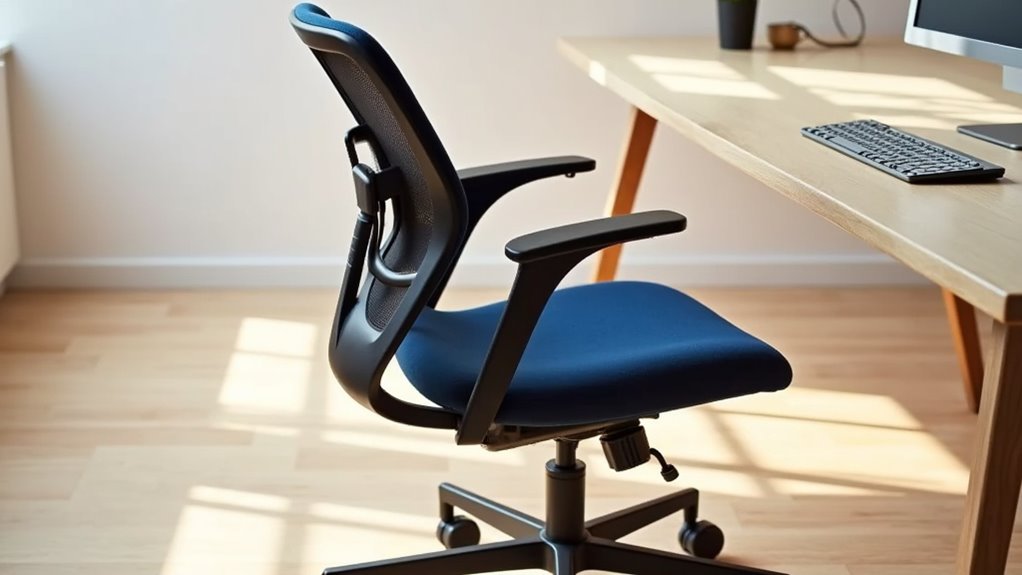How to Adjust an Office Chair
This post contains affiliate links. As an Amazon Associate, we earn from qualifying purchases.
To adjust your office chair effectively, begin by finding the seat height lever to ensure your feet rest flat on the floor, with hips and knees at a 90-degree angle. Next, adjust the seat depth to maintain a 2-4 inch gap behind your knees, then configure the backrest for optimal support of your lower back. Check the armrests for elbow comfort, and finally, tweak the tilt knob to achieve your ideal recline. For those looking for more detailed guidance and tips, keep reading for further insights!
Essential Facts in 30 Seconds
- Adjust seat height for flat feet and 90-degree knee angles.
- Set seat depth for a 2-4 inch gap behind your knees.
- Position backrest to support lower back at a 100° to 110° angle.
- Set armrests so elbows are bent at 90 degrees.
- Use tilt tension knob for adjustable reclining resistance.
Adjusting Seat Height
Getting the right seat height on your office chair is very important for comfort.
First, find the lever on the right side of your chair. To lower the seat, sit down and pull the lever. To raise it, stand up and pull the lever again. Your feet should be flat on the floor. Your hips and knees should be at about a 90-degree angle. Ideal position helps keep your back healthy and makes sitting easier. Adjusting your chair correctly can improve focus and reduce fatigue. Additionally, ensuring that your knees are at a right angle can prevent blood flow restriction and enhance overall comfort. Using a manual adjustment mechanism can provide alternative methods to achieve the right height if your chair lacks a lever.
Enjoy your work more with the right seat height!
Adjusting Seat Depth

Adjusting your office chair’s seat depth is key for comfort and support. A good seat depth helps you sit properly and reduces back strain. Additionally, ergonomic chairs are designed to promote natural spinal curves, which can greatly enhance your sitting experience. Proper seat depth also contributes to maintaining proper alignment of the spine, ensuring that you remain comfortable throughout the day. This ensures that blood circulation is not hindered during prolonged sitting. Furthermore, a proper seat depth can help prevent tension in legs and lower back discomfort.
Here’s how to adjust it:
- Sit back against the chair’s backrest. Measure from the back of your hips to about 2 inches behind your knees.
- Make sure there’s a 2-4 inch gap between the seat edge and the back of your knees.
- Use the lever under your chair. Slide the seat pan forward or backward until it feels comfortable.
Getting this right can improve your posture and keep you feeling great while you work!
Adjusting Backrest Position
Adjust your backrest position for comfort. The lumbar support should fit the curve of your lower back. It needs to feel soft, like a pillow. Avoid hard support that feels like a wall. Proper back support is crucial for maintaining spine alignment.
Set the backrest angle too. A slight recline works best. Imagine sitting in a cozy chair. This angle helps keep your spine healthy. Correct chair angle supports you while you work. Regular movement and breaks promote circulation and can enhance your comfort during long hours at your desk. Additionally, proper lumbar support is essential for reducing discomfort and fatigue during long hours.
Happy spine, happy you!
Lumbar Support Importance
A comfy office chair feels like a warm hug for your back. Lumbar support is vital for a healthy spine.
Here are some important benefits of good lumbar support:
- It helps keep your lower back’s natural curve. This reduces pressure on your spine.
- Better sitting posture prevents slouching and back pain.
- Adjustable support allows you to find the right fit for comfort. Proper chair selection can improve posture and reduce fatigue. Additionally, chair height adjustment ensures your legs feel relaxed and supported.
Investing in an ergonomic chair is about more than looks. It makes long hours at your desk much more pleasant. Proper adjustments to your chair can enhance your sitting position significantly, providing even more comfort and support.
Adjust that lumbar support and notice the difference! Your back will feel grateful, like a friend giving you a high-five.
Backrest Angle Adjustment
Adjusting your office chair’s backrest angle can greatly improve your comfort.
First, locate the backrest angle lever or knob near the seat. Lean back gently and twist it to change the backrest tilt. Aim for a comfy recline between 100° to 110°. This angle helps relieve pressure on your spine and supports your body better. Proper lumbar support is essential for maintaining good posture while sitting. Additionally, ensuring the backrest is at a suitable angle can prevent height adjustment issues that might arise from improper chair setup.
Once you find your ideal angle, lock the backrest in place. A well-adjusted backrest supports your lower back and reduces tiredness, promoting proper setup for overall sitting experience.
Sit longer without feeling uncomfortable. Enjoy your new comfort!
Adjusting Armrest Height

Let’s adjust those armrests for comfort!
Keep your elbows bent at 90 degrees. Your forearms should rest parallel to the floor. This helps avoid shoulder shrugging and awkward leaning. Regular maintenance can prolong the life of your chair and its components.
Not all armrests fit perfectly. No problem! You can adjust their height. Proper armrest height contributes to overall comfort, and make sure to achieve a 90-degree angle with your elbows for optimal support.
If that doesn’t work, consider removing them. It’s all about finding the best fit for you. Get comfy and ready to tackle your desk!
Ideal Elbow Position
Getting your armrests just right feels great! The right elbow position helps you stay comfortable. Follow these tips for the best setup:
- Set armrests to match your bent elbows. Your forearms should rest easily.
- Keep elbows at a 90-degree angle. This reduces shoulder strain.
- If armrests don’t fit well, remove them. A better posture will follow.
Finding comfort is key. Adjustments make a big difference for your body!
Width Adjustment Benefits
Now that your armrests are set for the perfect elbow position, it’s time to adjust the width. This step is crucial for your comfort.
Adjusting the width of your armrests keeps your shoulders relaxed and your upper body aligned. With the right seating, your arms rest comfortably without strain. No more feeling like a shrimp reaching for a snack! Additionally, maintaining correct sitting posture is key to enhancing your overall well-being while seated. Proper back support from your chair also plays a significant role in achieving comfort.
This adjustment also helps you avoid slouching, which can cause neck and back pain. The goal is to support your arms while you work. This makes your day easier and more efficient. Additionally, maintaining proper body positioning is essential for preventing discomfort during long periods of sitting.
Removing Non-Adjustable Armrests
Removing non-adjustable armrests can improve your comfort. Follow these simple steps to do it:
- Get your tools ready: You’ll need a screwdriver or a wrench.
- Take off the armrests: Unscrew the bolts or screws that hold the armrests.
- Check your chair: Make sure that removing them won’t affect the chair’s support or warranty.
Without armrests, you can enjoy more space. No more awkward shoulder scrunching!
Only remove them if they really bother you. Enjoy your comfortable seating!
Adjusting Tilt and Recline

Adjust the tilt and recline features of your office chair for comfort. Start by finding the tilt tension knob under your seat. Turn it clockwise to make reclining harder. Turn it counterclockwise to make reclining easier. Set it to match your body weight. This helps you lean back naturally.
Next, look for the tilt lock mechanism. It’s usually a lever or knob under the seat. This lets you lock your favorite recline angle. You can also unlock it for free movement. Most office chairs allow leaning back up to 135 degrees. Find the angle that feels best for you.
After making adjustments, test it out. If it feels off, make small changes. A comfy chair reduces stress on your back. Enjoy your time sitting!
Additional Ergonomic Considerations

Adjust your office chair for better comfort and health. A proper setup can help you avoid aches and keep your energy high.
Here are important ergonomic tips to consider:
- Foot support: Your feet should rest flat on the floor or on a footrest. This reduces strain on your lower back.
- Backrest height: Adjust the backrest to fit the curve of your lower back. This provides the support you need and helps you sit up straight.
- Armrest position: Set your armrests so your elbows are at a 90-degree angle. This reduces tension in your shoulders.
Remember to also look at other ergonomic tools. A good desk setup with a monitor stand or a keyboard tray can improve your posture and comfort.
Make these adjustments today. Your body will appreciate it!
Frequently Asked Questions
How Often Should I Adjust My Office Chair?
Adjust your office chair often throughout the day. This helps keep you comfortable and supported. Check your chair settings whenever you feel discomfort. Tasks change, so your chair should change too.
A good chair supports your back and promotes good posture. It should allow your feet to rest flat on the floor. Your knees should be at a 90-degree angle. Make sure your arms are level with the desk.
Regular adjustments can prevent pain and improve focus. A well-fitted chair can boost productivity. Don’t ignore discomfort; it means your chair needs adjusting. Listen to your body and make the necessary changes.
Can I Use a Chair Without Armrests?
Using a chair without armrests is perfectly fine. Many people find it comfortable. Chairs without armrests allow for more movement. They can help you shift positions easily. This can be important during long work hours.
Without armrests, you might feel more freedom. You can easily get up or sit down. This flexibility can enhance your focus and productivity.
Choose what feels best for you. Everyone has different preferences. Some like the support of armrests, while others prefer the openness of a chair without them. Consider trying both types to see what works for you.
What Type of Chair Is Best for Long Hours?
For long hours, a chair with ergonomic features is essential. Look for adjustable lumbar support. This helps your lower back stay comfortable. Breathable materials keep you cool. Comfort matters when you sit for long periods. A good chair reduces fatigue. It also supports your body’s natural posture. A well-designed chair can make a big difference in your work. You’ll feel more productive and at ease. Make sure to test the chair before buying. A good fit is important for your health. Choose wisely for a better sitting experience.
Are There Specific Adjustments for Different Body Types?
Adjust your chair’s height, depth, and armrests according to your body type. Proper ergonomic design matters. It helps align your body correctly. This alignment keeps you comfortable and reduces strain. Comfort leads to better posture. Better posture means more productivity during your day.
Everyone’s body is different. Tall people may need higher seats. Shorter individuals might need lower chairs. Wider chairs can help those with broader frames. Adjust the armrests too. They should support your arms without causing discomfort.
How Do I Maintain My Office Chair’s Adjustments?
Regular chair maintenance can make your office chair last 20% longer. Check adjustments every six months. Apply lubricants to keep parts moving smoothly. Clean all parts to remove dirt and dust. Make sure every feature works as it should. This will help your chair perform at its best. Taking these simple steps keeps your chair comfortable and functional.
Conclusion
Adjusting your office chair can make a big difference. A well-adjusted chair boosts comfort and can improve your focus by up to 30%. That’s extra time for you in your day!
Start with the height. Your feet should rest flat on the floor. Next, check the backrest. It should support your lower back. Adjust the armrests so your shoulders are relaxed.
Don’t forget the seat depth. You should have a few inches between the back of your knees and the chair. Finally, consider the tilt. A slight lean back can help you feel more comfortable.
A comfy chair leads to a happier you. So go ahead—make those adjustments. Enjoy your workspace!
